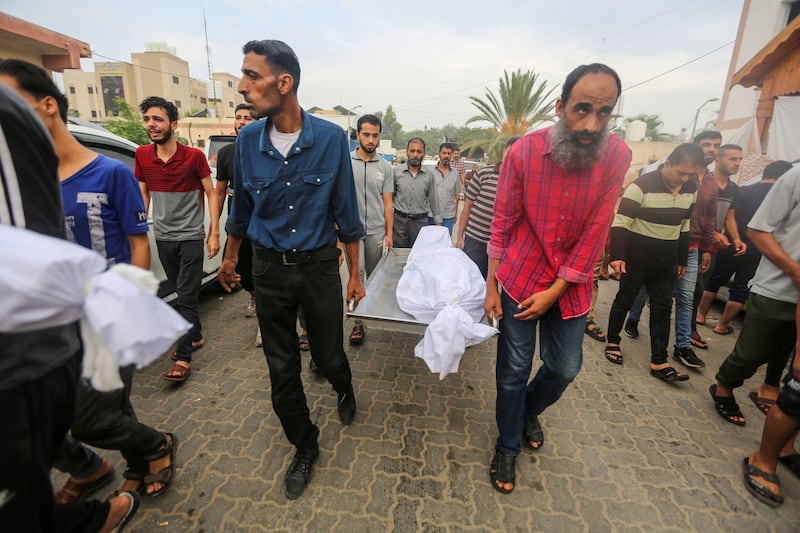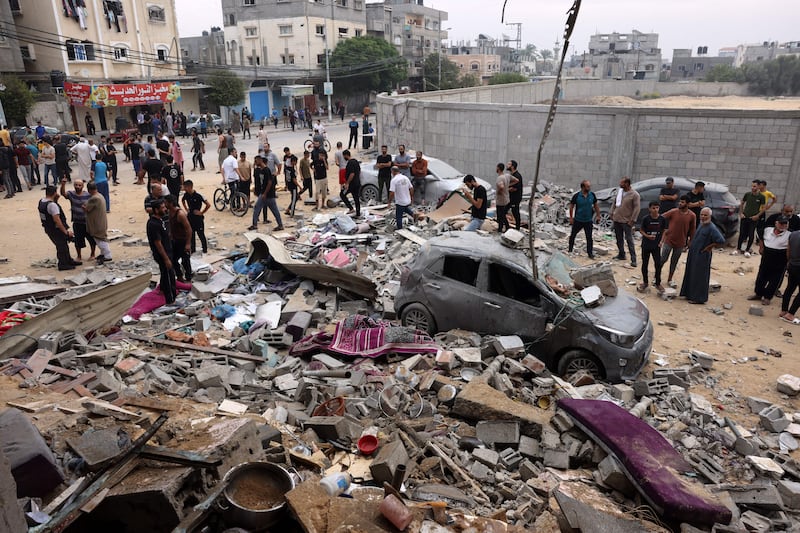The grainy video shows the roof of a building in southern Gaza. As the camera zooms in closer, steel tubes come into view. Then there is a sudden flash and the building explodes.
The footage is from a series of recordings taken last week by Israel Defense Forces (IDF) of its bombing campaign of Gaza. In this case, according to the IDF, the air strike destroyed a Hamas missile launch site hidden near a kindergarten and mosque.
It was one target in Israel’s three-week-long air campaign, an intense bombardment that has already destroyed swaths of Gaza — and has now stepped up a gear.
These [Israeli] military operations are being conducted in a territory that is, in parts, more overcrowded than Manhattan
Since Friday the IDF has deployed bombs powerful enough to send fireballs arcing into the sky, knocked out communications networks across the enclave, and ordered tanks and other forces into Gaza. The combined attack suggested that Israel’s long-expected ground offensive — its retaliation against a Hamas-led attack on October 7th that Israel claims killed more than 1,400 — is under way.
“The ground shook in Gaza,” said Israeli defence minister Yoav Gallant on Saturday morning, describing it as the “next stage” in the war that aims to eliminate Hamas. “We attacked above ground and underground.”
But these military operations are being conducted in a territory that is, in parts, more overcrowded than Manhattan. The Israeli bombing campaign, subsequent ground attacks and the order for civilians to leave the north of Gaza, have already displaced more than 1 million people, reduced neighbourhoods to rubble and destroyed more than 200 schools and universities, including 29 run by the UN.
That has raised concerns about the campaign’s strategic effectiveness as the mounting civilian death toll has enraged Middle Eastern audiences and threatened to undercut popular support among Israel’s allies.
Israeli forces face a “moral dilemma from hell”, said Shimrit Meir, who was diplomatic adviser to former Israeli prime minister Naftali Bennett. She noted the tension between their need to eliminate Hamas as a threat while preserving the lives of hostages and Palestinian civilians and maintaining international support.
IDF officials have acknowledged that the air campaign and ground attacks will exact a deadly toll on Gaza’s 2.3m population, which is crammed into a sliver of land 40km long and 12km wide
Even by Thursday, the 20th day of the campaign, Israeli forces had already fired more than 8,000 munitions into Gaza, according to the IDF. That is more than the 5,000 munitions that coalition forces fired at Isis fighters in Iraq during the most intense period of the battle for Mosul in March 2017, according to Airwars, a UK-based group that monitors civilian harm.
By Saturday, it had also left about 7,700 Palestinians dead, according to Gaza’s Hamas-controlled health ministry, surpassing the estimated 5,400 people killed in conflicts with Israel since Hamas took control of Gaza in 2007.
IDF officials have acknowledged that the air campaign and ground attacks will exact a deadly toll on Gaza’s 2.3 million population, which is crammed into a sliver of land 40km long and 12km wide. “Every victory comes at a price,” said Gen Herzi Halevi said on Saturday. “But in order to expose and destroy the enemy, there is no other way than to enter its territory with force.”
The IDF insists it seeks to abide by international law and to minimise casualties by using precision attacks on pre-selected targets identified by Israeli intelligence. It also accuses Hamas of breaking international law by using civilians to shield its estimated 30,000 fighters and of storing armaments in a 400km network of tunnels, many of which run under and exit into civilian sites such as hospitals and schools.
“We know they [the tunnels] are under the Shifa hospital,” said Meir, the former government aide. “There is also the case of the manager at the Indonesian hospital [in north Gaza] who was advised to relocate, but he replied under coercion: ‘I’d rather be a martyr’.”

Hamas officials have called such Israeli claims “baseless ... and lies”.
How effective the IDF’s bombing campaign has been remains unclear. Hamas and its ally, Palestine Islamic Jihad, have continued to fire rockets from concealed sites into Israeli territory. Although Hamas’s current rate of fire has slowed, that could be because the group is conserving inventory, according to analysts.
“The goal should be to eliminate Hamas’s military capabilities, especially [its] missile capability,” said Meir. “That’s the biggest threat to Israeli security. It is like a gun constantly pointed to our heads.”
The IDF’s latest attack, which continued into Saturday, was the biggest in a series of four, rapid-fire raids that Israel has launched into the strip over the past week and which analysts said served several purposes, chief among them to throw Hamas commanders off balance.
“What we are seeing — on multiple axes — is the Israelis moving fast with many concurrent raids. Not only ... to confuse Hamas commanders about what is happening and why, but ... to ensure [the Hamas leadership’s] responses are always just a little too late,” wrote Mick Ryan, a military analyst and former Australian army general.
Ryan added that “by generating a lot of activity” the Israelis will hope it prompts Hamas fighters to come out of the tunnels and fight, “so they can be detected and destroyed”.
Analysts said the recent Israeli land raids would have been used to gather intelligence on the impact of the bombing campaign so far and to sharpen the IDF’s tactics for the fighting still to come
The IDF also says it has killed dozens of Hamas’s military commanders, including the group’s deputy head of intelligence Shadi Barud, who planned the October 7th raid. But it is widely believed most senior leaders and fighters remain safe below ground.
That was the case in 2021, the last time Israel launched a Gaza offensive, when the air force dropped almost 500 bunker-busting bombs — each carrying a tonne of explosives — in just 30 minutes. The IDF had tried to trick Hamas into taking up fighting positions by announcing a ground invasion. But the feint failed and the Israeli army later admitted that Hamas suffered few casualties from the bombing.
Analysts said the recent Israeli land raids would have been used to gather intelligence on the impact of the bombing campaign so far and to sharpen the IDF’s tactics for the fighting still to come.
“The IDF learns its lessons and that any bombing campaign has to be led by intelligence — that it needs to know where the tunnels lie and how deep they are,” said Edward Stringer, a former British air marshal who oversaw the Nato-led air campaign in Libya in 2011.

“The alternative is level the city, create a desert and then call it peace. The IDF has to tread a fine line between avoiding humanitarian catastrophe and active self-defence.”
The US, while backing Israel’s right to self-defence, has urged restraint. On Thursday, nine Arab countries — including Saudi Arabia and Egypt — condemned “the targeting of civilians”, making clear that included Hamas’s attack and Israel’s retaliatory aerial bombardment.
The IDF has curtailed “roof-knocking”, a process used in past conflicts whereby dud munitions were fired at a building to warn residents to leave. Israeli jets have also continued to hit sites in southern Gaza despite an influx of people from the north, with the IDF saying the homes of militants are “legitimate targets” even if civilians live there too.
Such strikes illustrate how Hamas has embedded its military infrastructure deeply within the wider Palestinian population, which has little ability to refuse the group
According to residents, one strike on Wednesday brought down several apartment blocks in Khan Younis, about 10km from the Egyptian border.
However, another hit destroyed a depot of Hamas rockets stored under a building, sending a huge black cloud of smoke into the sky. Michael Knights, a military analyst at the Washington Institute of Near East Policy, described the incident as “neighbourhood-sized [improvised explosive devices] ... with civilians living on top”.
Such strikes illustrate how Hamas has embedded its military infrastructure deeply within the wider Palestinian population, which has little ability to refuse the group.
There is no other way to separate over 2m people from the group. Telling Gaza’s civilian population to move south for their safety is simply not meaningful.
— Bombing to Win author Robert Pape
Robert Pape, author of the seminal study on air power Bombing to Win, said they also demonstrated why Israel’s bombing campaign would probably not achieve its objectives.
“To separate Hamas from the broader population has to be a political process,” said Pape. “There is no other way to separate over 2 million people from the group. Telling Gaza’s civilian population to move south for their safety is simply not meaningful.”
Pape added: “History shows that mass bombing campaigns never break the enemy’s will. It does the opposite. Yet it is a mistake made again and again by societies that have been hurt and wounded and want to hit back.” — Copyright The Financial Times Limited 2023










